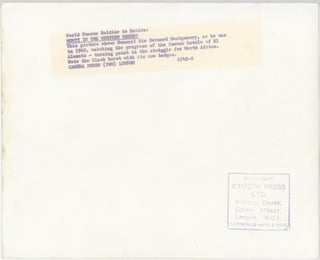"MONTY IN THE WESTERN DESERT" - a 5 November 1942 Second World War image of then-General Bernard Law Montgomery in the turret of his Grant command tank at El Alamein, originally captured by a member of the Army's Film & Photographic Unit and signed and dated by Montgomery on 22 May 1972
London: Copyright Camera Press Ltd. Photograph. This signed photograph shows then-Lieutenant General Bernard Montgomery “in the turret of his Grant command tank at El Alamein, 5 November 1942.” (Imperial War Museum) This image is signed and dated in two lines of blue ink at the upper left “Montgomery of Alamein | 22-5-72”. First used in North Africa in 1942, Grant tanks earned the nickname “Egypt’s last hope” in the defensive victory at Alam Halfa, Montgomery’s first in command of the Eighth Army.
The print measures 8 x 10 inches (20.3 x 25.4 cm). The verso bears the ink stamp copyright of “Camera Press Ltd.” of London. The original, typed Camera Press caption is titled “World Famous Soldier to Retire: MONTY IN THE WESTERN DESERT” and reads “This picture shows General Sir Bernard Montgomery, as he was in 1942, watching the progress of the famous battle of El Alamein – turning point in the struggle for North Africa. Note the black beret with its two badges.” Camera Press parenthetically credits “IWM” at the end of the caption and IWM holds this image in its archives, attributing the photograph to Major Geoffrey Keating of the No. 1 Army Film & Photographic Unit.
Condition of the image is very good, the image distinct and unfaded with trivial wear confined to extremities and minimal surface scratches visible only under raking light. This photograph is housed in a removable, archival mylar sleeve within a rigid, crimson cloth folder.
Nearly two and a half millennia after Thucydides discussed the unpredictable role of chance in war, Bernard Law Montgomery (1886-1976) and the Eighth Army found one another in North Africa. In July 1942, British troops checked Rommel’s forces in the First Battle of El Alamein, but Allied momentum then stalled. Churchill flew to Cairo on 1 August to assess command, replacing Middle East Commander-in-Chief Claude Auchinleck with General Harold Alexander and appointing General Gott to command the Eighth Army. However, Gott was killed on 7 August flying back to Cairo. Churchill acceded to General Bernard Montgomery in Gott’s stead. Montgomery seized command two days earlier than authorized by his C-in-C and began a “historic transformation of a beaten body of men into the legendary Eighth Army that fought its way from Alamein to Tunisia between August 1942 and May 1943.” (ODNB)
North Africa and the Eighth Army proved the perfect milieu for Montgomery’s “messianic vitality and vanity”. By May 1943, Rommel was beaten, the Germans expelled from North Africa, and Montgomery’s C-in-C, Harold Alexander, sent Churchill the message: “… the Tunisian campaign is over… We are masters of the North African shores.” (THoF, p.780) Montgomery went on to command the Eighth Army in Sicily and Italy and would later say, with characteristic modesty, “It went from Alamein half way up Italy without losing a battle or even a serious action, and without ever withdrawing a yard.” Montgomery was recalled to England in December 1943 to become commander-in-chief of Allied ground forces during the D-day landings. After the war he rose to Chief of the Imperial General Staff and was elevated to Viscount Montgomery of Alamein. Arrogant, outspoken, and politically inept, Montgomery seldom missed either controversy or opportunity for self-promotion. During the war he was often criticized by Allied commanders for his caution and slowness to strike. Montgomery’s uncharitable accusations in his postwar memoirs lost him the friendship of President Eisenhower and forced Montgomery to publicly apologize to a fellow Field Marshal whom - ironically - he accused of being too slow to fight. Montgomery earned further criticism for declaring support for Apartheid and praising communist Chinese leadership. Irrespective of his political and diplomatic limitations, “Monty” remains iconic in his beret, widely regarded as “the outstanding British field commander of the twentieth century” (ODNB) and the most readily recognized and widely lauded British military leader of the Second World War. Item #005854
Price: $1,500.00


